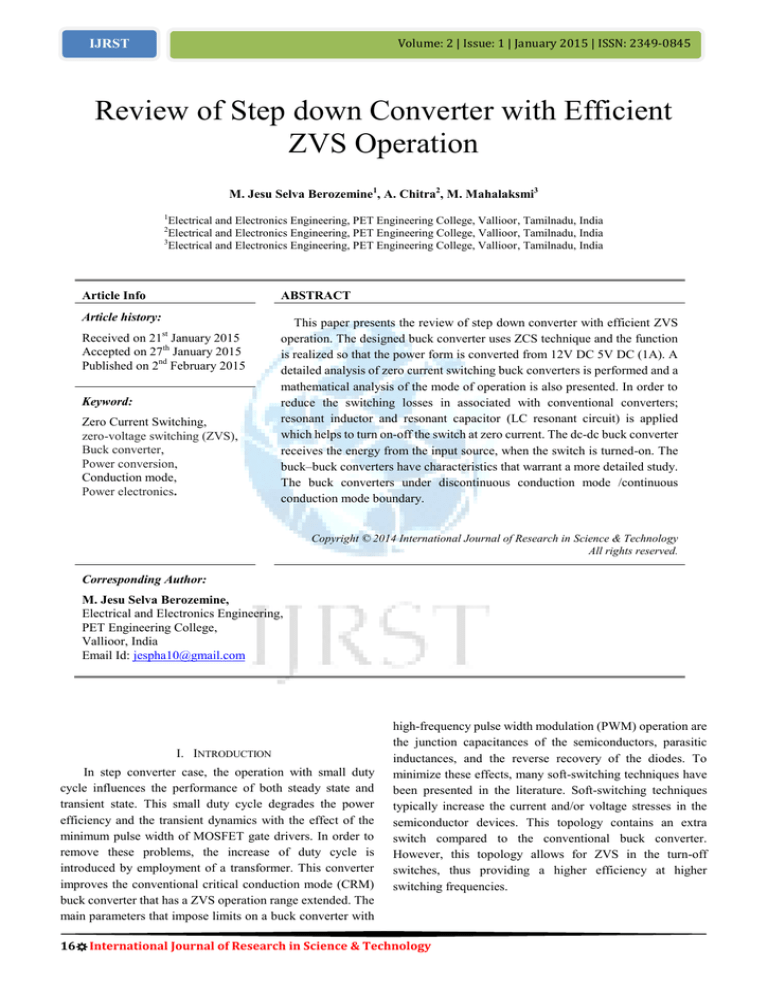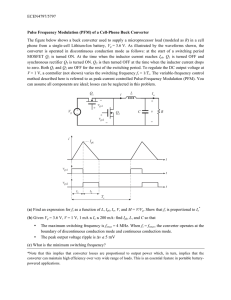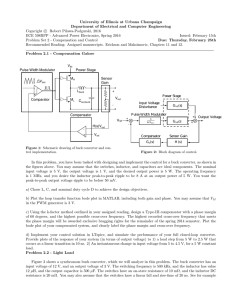
Volume: 2 | Issue: 1 | January 2015 | ISSN: 2349-0845
IJRST
Review of Step down Converter with Efficient
ZVS Operation
M. Jesu Selva Berozemine1, A. Chitra2, M. Mahalaksmi3
1
Electrical and Electronics Engineering, PET Engineering College, Vallioor, Tamilnadu, India
Electrical and Electronics Engineering, PET Engineering College, Vallioor, Tamilnadu, India
3
Electrical and Electronics Engineering, PET Engineering College, Vallioor, Tamilnadu, India
2
Article Info
ABSTRACT
Article history:
This paper presents the review of step down converter with efficient ZVS
operation. The designed buck converter uses ZCS technique and the function
is realized so that the power form is converted from 12V DC 5V DC (1A). A
detailed analysis of zero current switching buck converters is performed and a
mathematical analysis of the mode of operation is also presented. In order to
reduce the switching losses in associated with conventional converters;
resonant inductor and resonant capacitor (LC resonant circuit) is applied
which helps to turn on-off the switch at zero current. The dc-dc buck converter
receives the energy from the input source, when the switch is turned-on. The
buck–buck converters have characteristics that warrant a more detailed study.
The buck converters under discontinuous conduction mode /continuous
conduction mode boundary.
Received on 21st January 2015
Accepted on 27th January 2015
Published on 2nd February 2015
Keyword:
Zero Current Switching,
zero-voltage switching (ZVS),
Buck converter,
Power conversion,
Conduction mode,
Power electronics.
Copyright © 2014 International Journal of Research in Science & Technology
All rights reserved.
Corresponding Author:
M. Jesu Selva Berozemine,
Electrical and Electronics Engineering,
PET Engineering College,
Vallioor, India
Email Id: jespha10@gmail.com
I. INTRODUCTION
In step converter case, the operation with small duty
cycle influences the performance of both steady state and
transient state. This small duty cycle degrades the power
efficiency and the transient dynamics with the effect of the
minimum pulse width of MOSFET gate drivers. In order to
remove these problems, the increase of duty cycle is
introduced by employment of a transformer. This converter
improves the conventional critical conduction mode (CRM)
buck converter that has a ZVS operation range extended. The
main parameters that impose limits on a buck converter with
16
high-frequency pulse width modulation (PWM) operation are
the junction capacitances of the semiconductors, parasitic
inductances, and the reverse recovery of the diodes. To
minimize these effects, many soft-switching techniques have
been presented in the literature. Soft-switching techniques
typically increase the current and/or voltage stresses in the
semiconductor devices. This topology contains an extra
switch compared to the conventional buck converter.
However, this topology allows for ZVS in the turn-off
switches, thus providing a higher efficiency at higher
switching frequencies.
International Journal of Research in Science & Technology
Review of Step down Converter with Efficient ZVS Operation
In PWM buck converters under discontinuous
conduction mode (DCM)/continuous conduction mode
(CCM) boundary, power switches may be turned on at ZVS
condition like those in QR converters. Resonant components
are not required, and voltage stress of the power switch during
its OFF time is just the same as that in conventional PWM
converters.
The switching frequency of switches should be higher to
diminish the size of a converter (LC filter). As a result, losses
(e.g., switching loss of switchers) in connection with
frequency may increase, which would cause to the decrease in
the efficiency of the converter. Many techniques have been
proposed
to
reduce
the
losses
arising from
switching frequency. Pulse frequency modulation (PFM)
control and double-mode control combination of pulse width
modulation (PWM) and PFM have been widely applied.
II. STEP DOWN CONVERTER
The basic operation of the buck converter has the current in
an inductor controlled
by
two
switches
(usually
a transistor and a diode). In the idealized converter, all the
components are considered to be perfect. Specifically, the
switch and the diode have zero voltage drop when on and zero
current flow when off and the inductor has zero series
resistance. Further, it is assumed that the input and output
voltages do not change over the course of a cycle.
commutation cycle. In this mode, the operating principle is
described by the plots.
When the switch pictured above is closed (on-state,
top of figure 2), the voltage across the inductor is
.
The current through the inductor rises linearly. As the diode is
reverse-biased by the voltage source V, no current flows
through it;
When the switch is opened (off state, bottom of figure 2), the
diode is forward biased. The voltage across the inductor is
(neglecting diode drop). Current IL decreases
The energy stored in inductor is
B. Discontinuous Conduction Mode
In some cases, the amount of energy required by the load
is too small. In this case, the current through the inductor falls
to zero during part of the period. The only difference in the
principle described above is that the inductor is completely
discharged at the end of the commutation cycle.
We still consider that the converter operates in steady
state. Therefore, the energy in the inductor is the same at the
beginning and at the end of the cycle (in the case of
discontinuous mode, it is zero). This means that the average
value of the inductor voltage (VL) is zero
(
The output current delivered to the load ( ) is constant,
as we consider that the output capacitor is large enough to
maintain a constant voltage across its terminals during a
commutation cycle. This implies that the current flowing
through the capacitor has a zero average value.
C. Hard Switching
Fig.1 Step down converter
III. BUCK CONVERTER OPERATION
The original concept of a “Buck Converter” requires that the
input voltage is chopped, in amplitude and develops the lower
amplitude voltage at the output. A buck converter has
switch-mode dc-dc conversion with the advantages
of simplicity and low cost. The fig.1 shows a simplified
non-isolated buck converter, which allows a dc input and
employs pulse-width modulation (PWM) of switching
frequency to control the output of an internal power
MOSFET. An act in concert external diode, external inductor
and output capacitor, produce the regulated dc output. A Buck
or step down converters are designed to produce an average
output voltage lower than the input source voltage.
Reduction of size and weight of converter systems require
higher operating frequencies, which would reduce sizes of
inductors and capacitors. However, stresses on devices are
heavily influenced by the switching frequencies accompanied
by their switching losses. It is obvious that
switching-aid-networks do not mitigate the dissipation issues
to a great extent. Turn-on snubbers though not discussed are
rarely used. Even if used, it would not be able to prevent the
energy stored in the junction capacitance to discharge into the
transistor at each turn-on.
A. Continuous Conduction Mode
A buck converter operates in continuous mode if the
current through the inductor (IL) never falls to zero during the
17
International Journal of Research in Science & Technology
Fig.2 Hard switching
Volume: 2 | Issue: 1 | January 2015 | ISSN: 2349-0845
IJRST
D. Soft Switching
Soft switching techniques use resonant techniques to
switch ON at zero voltage and to switch OFF at zero current.
There are negligible switching losses in the devices, though
there is a significant rise in conduction losses. There is no
transfer of dissipation to the resonant network which is
non-dissipative.
IV. ZERO VOLTAGE SWITCHING
Zero Voltage Switching means that the power to the load
(heater or cooler or other device) is switched on or off only
when the output voltage is zero volts. Zero Voltage Switching
can extend the life of a controller and of the load being
controlled. Controllers with Zero Voltage Switching use
triacs instead of mechanical relays, and, in fact, all of our
temperature controllers which use a triac are inherently Zero
Voltage Switching.
Fig.3 ZVS operation diagram
The ZVS buck converter operates in three main states.
They are defined as Q1 on phase, Q2 on phase, and clamp
phase. Q1 turns on at zero current and when the
drain-to-source voltage is nearly zero. Current ramps up in the
MOSFET and the output inductor to a peak current
determined by the on-time of Q1, the voltage across the
inductor, and the inductor value. During the Q1 on phase,
energy is stored in the output inductor and charge is supplied
to the output capacitor. During the Q1 on phase, the power
dissipation in Q1 is dominated by MOSFET on-resistance and
the switching loss is negligible.
Next, Q1 turns off rapidly followed by a very short body
diode conduction time (adding negligible power dissipation).
During the current commutation to the body diode, Q1 does
experience turn-off losses in proportion to the peak inductor
current. Next, Q2 turns on and the energy stored in the output
inductor is delivered to the load and output capacitor. When
the inductor current reaches zero, the synchronous MOSFET
Q2 is held on long enough to store some energy in the output
inductor from the output capacitor.
Fig. 4. Waveform for mode analysis
Once the controller has determined that there is enough
energy stored in the inductor, the synchronous MOSFET
turns off and the clamp switch turns on, clamping the VS node
to VOUT. The clamp switch isolates the output inductor
current from the output while circulating the stored energy as
current in a nearly lossless manner. During the (very small)
clamp-phase time the output is supplied by the output
capacitor.
When the clamp phase ends, the clamp switch is opened.
The energy stored in the output inductor resonates with the
parallel combination of the Q1 and Q2 output capacitances,
causing the VS node to ring towards VIN. This ring discharges
the output capacitance of Q1, diminishes the gate-to-drain
(Miller) charge of Q1 and charges the output capacitance of
Q2. This allows Q1 to turn on in a lossless manner when the
VS node is nearly equal to VIN.³
V. ZERO CURRENT SWITCHING
Reducing stress on the switching components is a major
incentive for resonant operation and we need to understand
18
International Journal of Research in Science & Technology
Review of Step down Converter with Efficient ZVS Operation
ways through which that might be fulfilled. The simplest
approach and the one to which most of this paper presents
ZCS operation of converter switch must be such that involves
the current flowing through the switch being induced to rise
gradually just after the switch is turned-on. The switch current
must also be induced to descend gradually just before the
switch is turned-off. The ZCS turn-on feature of a converter
switch can beamed certain by simply connecting an inductor
in series as the current flowing through the other devices in
the converter is gradually drawn back so that they can turn-off
with ZCS
[8]
[9]
[10]
[11]
[12]
[13]
Fig.5 Zero current switching
VI. CONCLUSION
This paper presented a step down converter with an
improved zero-current-switching (ZCS) PWM switch cell.
The improved ZCS PWM switch cell provides
zero-current-switching conditions for the main switch and the
auxiliary switch without additional conduction loss of the
main switch. The additional conduction losses for the soft
switching are minimized, since the circulating current for the
soft switching flows only through the auxiliary circuit and
minimum number of switching devices are involved in the
circulating current path. The diodes commutate softly and
reverse recovery problems are alleviated.
[14]
[15]
tapped-inductor,” IEEE Trans. Power Electron., vol. 20, no.
4, pp. 762–774, Jul. 2005.
J.-H. Park and B.-H. Cho, “Nonisolation soft-switching buck
converter with trapped-inductor for wide-input extreme
step-down applications,” IEEE Trans. C ircuits Syst. I , Reg.
Papers, vol. 54, no. 8, pp. 1809–1818, Aug. 2007.
N. Z. Yahaya, K. M. Begam, and M. Awan, “Experimental
analysis of a new zero-voltage switching synchronous
rectifier buck converter,” IET Po wer Electron., vol. 4, no. 7,
pp. 793–798, Aug. 2011.
S. Urgun, “Zero-voltage transition-zero-current transition
pulsewidth modulation DC–DC buck converter with
zero-voltage switching-zerocurrent switching auxiliary
circuit,” IET Power Electron., vol. 5, no. 5, pp. 627–634, May
2012.
J.-M. Wang, S.-T. Wu, and G.-C. Jane, “A novel control
scheme of synchronous buck converter for ZVS in light-load
condition,” IEEE Trans. Po wer Electron., vol. 26, no. 11, pp.
3265–3273, Nov. 2011.
J. P. Rodrigues, A. J. Perin, S. A. Mussa, and M. L. Heldwein,
“Threelevel ZVS active clamping PWM for the DC–DC buck
converter,” IEEE Trans. Power Electron., vol. 24, no. 10, pp.
2249–2258, Oct. 2009.
C.-Y. Chiang and C.-L. Chen, “Zero-voltage-switching
control for a PWM buck converter under DCM/CCM
boundary,” IEEE Trans. Power Elect ro n ., vol. 24, no. 9, pp.
2120–2126, Sep. 2009.
B. P. Divakar, K. W. E. Cheng, and D. Sutanto, “Zero-voltage
and zerocurrent switching buck-boost converter with low
voltage and current stresses,” IET Power Electron., vol. 1, no.
3, pp. 297–304, Sep. 2008.
R. T. Naayagi, A. J. Forsyth, and R. Shuttleworth, “High
power bidirectional DC–DC converter for aerospace
application,”
IEEE
Trans.
Power
Electron., vol. 27, no. 11, pp. 4366–4379, Nov. 2012.
Author Profile
REFERENCES
[1]
[2]
[3]
[4]
[5]
[6]
[7]
19
Y.-C. Chuang and Y.-L. Ke, “A novel high-efficiency battery
charger with a buck zero-voltage-switching resonant
converter,” IEEE Trans. Energy Convers., vol. 22, no. 4, pp.
848–854, Dec. 2007.
S. Pattnaik, A. K. Panda, and K. Mahapatra, “Efficiency
improvement of synchronous buck converter by passive
auxiliary circuit,” IEEE Trans. I n d . A p p l ., vol. 46, no. 6,
pp. 2511–2517, Nov./Dec. 2010.
H.
Mao, O. A. Rahman, and I. Batarseh,
“Zero-voltage-switching
DC–DC
converters
with
synchronous rectifiers,” IEEE Trans. Power Electron., vol.
23, no. 1, pp. 269–378, Jan. 2008.
C. S. Moo, Y. J. Chen, H. L. Cheng, and Y. C. Hsieh,
“Twin-buck converter with zero-voltage transition,” IEEE
Trans. I nd. Electron., vol. 58, no. 6, pp. 2366–2371, Jun.
2011.
E. Adib and H. Farzanehfard, “Zero-voltage-transition PWM
converters with synchronous rectifier,” IEEE Trans. Power
Electron., vol. 25, no. 1, pp. 105–110, Jan. 2010.
E. Adib and H. Farzanehfard, “Family of zero current zero
voltage transition PWM converters,” IET Power Electron.,
vol. 1, no. 2, pp. 214–223, Jun. 2008.
J.-H. Park and B.-H. Cho, “The Zero Voltage Switching
(ZVS) Critical Conduction Mode (CRM) buck converter with
International Journal of Research in Science & Technology
M. Jesu Selva Berozemine currently pursuing
M.E degree under the specialization of Power
Electronics & Drives under the department of
EEE
from
PET
engineering
college
Vallioor,Tamilnadu,India
A. Chitra currently working as an Assistant
professor of PET Engineering College in the
department of Electrical and Electronics
Engineering. Her research area interest includes
Multilevel Inverter and Renewable Energy
systems.
M. Mahalaksmi is currently working as an
Assistant Professor of PET Engineering college
in the department of Electrical and Electronics
Engineering. Her research area interest includes
Control Systems and Embedded systems.





